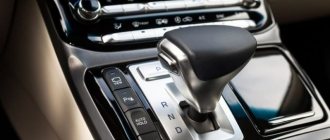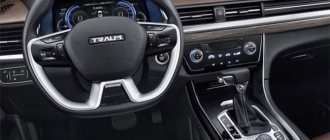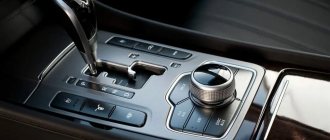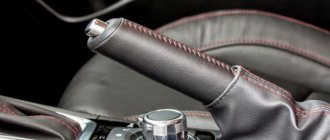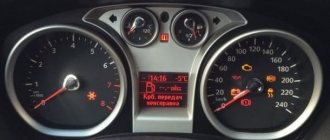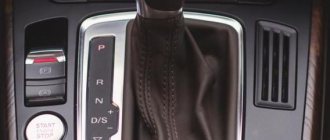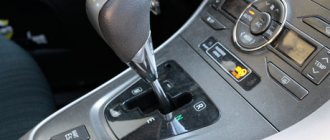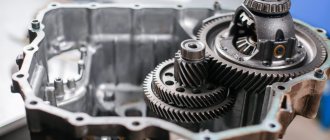Today, cars with various types of automatic transmissions are actively replacing models with a traditional manual transmission. Even taking into account the higher cost, a car with an automatic transmission provides greater comfort and also greatly simplifies the operation of the vehicle (especially if we talk about novice drivers).
At the same time, taking into account the apparent ease of operation, the “automatic” also needs to be used correctly. In other words, you need to know how to operate an automatic transmission, since certain errors can lead not only to a reduction in service life, but also to serious damage to the automatic transmission.
In this article we will look at the modes and features of the “classic” hydromechanical gearbox, since robotic manual transmissions (AMT) differ from automatic transmissions and will be considered separately.
How to drive an automatic - features of cars with automatic transmission
In an automatic transmission, gear shifting is carried out only depending on the speed. When a certain threshold is reached, a transition occurs from one stage to another. This is accomplished thanks to built-in electronics and gear pairs controlled by solenoids. There is also a clutch that ensures a smooth transition from one stage to another.
As practice shows, driving an automatic is much easier than driving a car with a manual transmission. Everything is explained by the operating principle of the automatic transmission and the absence of a third clutch pedal. It is important to remember one thing: every time at the beginning of a standing start, you should press the gas pedal smoothly.
Features of a car with automatic transmission include:
- simplicity and ease of operation of the machine;
- no need to change gears yourself;
- Modern automatic transmissions have no shorter service life than mechanical ones.
The history of the automatic transmission
The idea of creating an automatic transmission belongs to the German engineer Hermann Fettinger, who developed the first torque converter in 1902, and at first such a transmission was used only for the construction of ships.
The first car equipped with a planetary automatic transmission was the American Ford T. After the release of this car, the most active role in the development of automatic transmissions was played by General Motors, which managed to release a semi-automatic transmission in the mid-1930s. The same GM created the first completely automatic transmission in 1940
Basic operating modes of automatic transmission
In cars with automatic transmission, there is no need to change gears. This transmission is equipped with an operating mode switch that determines at what point the transition from one stage to another will occur. The automatic transmission is controlled by buttons and a lever. In this regard, the transmission, on the contrary, is somewhat complicated, because in a manual car there is only a lever and a pedal. Despite the increased number of controls, the control process is much simpler. It is important to know that such a transmission has primary and secondary operating modes. The first include:
- “P” - this Latin letter indicates the activation of the parking mode. The drive wheels are locked and the engine is disconnected from the transmission. It is in this position of the lever that the motor should be started, since there is no load on its shaft.
- “R” - the position of the transmission lever in this mode indicates that reverse gear is engaged. It is activated electronically and only when the machine is completely stopped.
- “N” - if you plan to tow a car, then you need to do it in this mode. The motor is disconnected from the transmission and the drive wheels are not locked.
- “D” - this position of the lever indicates forward movement. It should be turned on whenever you travel.
- “M” - this sign on the automatic transmission indicates that the automatic transmission’s gears are shifted manually, but it is not available on all car models with similar gearboxes.
Additional automatic transmission operating modes
To properly use an automatic transmission, you need to learn additional operating modes. They are also called submodes. Perhaps not all modifications of the boxes will be marked exactly as will be described later in the article:
- Overdrive mode is designated “D” or “O/D”. It is designed for long periods of driving at high speeds. Used outside the city.
- The letters “D3” or “O/D OFF” indicate turning off the overdrive mode. It forcibly disables the 4th stage so that it does not operate during a short-term increase in speed. Allows you to save the life of the torque converter clutch when driving around the city.
- The position of the lever at the “S” or “2” marks indicates the activation of the reduced speed mode. It should be turned on if you plan to drive slowly for a long time. It is used for confident movement on icy roads. In some car modifications, the position is marked with the letter “W”.
- The position of the lever at the “L” or 1 mark means that only the first stage is turned on. It is used in transmission diagnostic or repair mode. You can also turn it on to start on uneven surfaces and then move at creeping speed.
Modes of modern cars
In modern automatic transmissions, to improve vehicle traffic safety, an additional emergency mode has been introduced. It is often not marked in any way, but the system automatically switches to it if a problem is detected in the stage control mechanisms or components. The driver learns about its activation by the corresponding pictogram on the dashboard. In this position, it is possible to drive at a minimum speed, which should be enough to get to the car service center.
Also in modern boxes there are the following operating modes:
- d overdrive;
- Kick down;
- Pwr sport;
- Snow.
Od overdrive _
Learning to drive a car with an automatic transmission includes the use of the O/D overdrive mode. It was already mentioned earlier in the article, but it’s worth remembering. It is needed to block the 4th stage when driving with a short increase in speed. Forced disconnection of the torque converter clutch of this transmission saves its resource. The mode is activated by pressing or releasing a button located directly on or near the lever. The shield usually has a yellow warning indicator.
It should be turned on when driving in traffic at a speed of 40-60 km/h and frequently pressing the brake pedal. If you turn it off, the car will become noticeably slower, since getting out of the 4th stage requires high speed, and when in traffic this is not acceptable.
Kick down
If you press the gas pedal sharply, the so-called Kick down mode is automatically called up. This leads to the switching off of the higher stage and transition to the lower stage. This mode is needed to maintain a smooth speed increase and avoid sudden transitions. When the revolution reaches the desired level, the proportion of upshifts will occur, and a transition to a higher gear will occur.
Pwr sport
In Pwr sport mode, upshifting occurs when the maximum speed in the current gear is reached. This ensures the best dynamics, and the engine develops maximum power. Used when driving at high speeds.
Snow
Snow mode is activated when driving on slippery or wet roads, where traction is noticeably worse. If it is activated, then when the gear lever is in position “D”, the car starts off in the second stage.
Is it possible to change automatic transmission speeds on the go?
The presence of gas and brake pedals in the cabin indicates the presence of an automatic transmission in the car. This obliges the driver to learn how to use it correctly. While in motion, that is, when the car is not standing still, there are not many actions that can be performed. For example, you cannot shift the automatic transmission while driving:
Switch from D to N so that the car coasts without steps. This will lead to loss of connection with the wheels and an emergency situation on the road.
You can switch:
- Enable or disable the 4th stage D/O blocking mode.
- Switch from D to S mode for high-speed driving on the autobahn.
- Change gears when manual control is activated, that is, “M” mode. It is not available on all modifications of boxes. Allows you to switch between modes “1” or “L”, “2” and “3”, respectively, at a maximum speed of 25, 50 and 120 km/h.
Repair Tips
What repair recommendations should you consider:
- When performing repair work, be careful and do not allow new damage to appear on the gearbox.
- The place where repairs are carried out should be as clean as possible. Otherwise, dirt and debris may get into the gearbox, which will subsequently lead to contamination and poor performance. Because of this, when performing repair work, there is no need to use knitted gloves or wipe transmission components with such rags. It is better to use nylon rags or napkins.
- When performing repairs, automatic transmission components and elements must be washed and dried with compressed air. Washing powder is used to clean steel components. As for friction linings, as well as plastic and rubber elements, transmission oil is used to clean them.
- If the transmission housing is damaged, it is necessary to disassemble and flush the transmission cooling system.
- Always monitor the level of lubricant in the box and its condition. If the oil loses its properties, it becomes less viscous, darker, and wear products appear in it.
- When disassembling the unit for repairs, all parts and mechanisms must be placed on the table in the order from dismantling, so as not to mix up the elements during assembly. Pay attention to the installation location of thrust washers, sealing components, valves, thrust rings, crankcase screws.
- If your car's transmission is equipped with a chain drive, then during repairs it is diagnosed for rapid wear. To check, measure its deflection in the middle of the chain itself in two directions. Its total deflection should be no more than 2.7 cm. If this parameter is greater, then the chain needs to be replaced.
- When performing repairs, remember how the cables are routed and the plugs with wires are connected to the valve box. If you mix up the connectors during further connection, this will lead to malfunctions in the gearbox. Sometimes removing the plugs is problematic; try not to pull the connectors by the wires.
- If the hydraulic accumulator springs are similar and you might confuse them, then label or mark them. When spring elements differ in color, color cannot be used as an indication of the installation location. If the parts are installed incorrectly, this will affect the quality of switching transmission modes.
- Be careful when removing the brake band. Its deformation will lead to operational problems. Damaged tape must be replaced.
- After thoroughly washing and drying the parts and components, all elements are subject to visual inspection. It is necessary to identify the level of wear and understand whether they can continue to be used. Carefully inspect the contact surfaces of the bushings and thrust washers; if there is damage or signs of wear, these components are replaced. There should be no traces of rust, peeling, etc. on the bearing element housing.
- During repairs, it may be difficult to remove the gaskets. To prevent defects from appearing on the aluminum surface of the crankcase and to efficiently remove sealant residues, use a special aerosol and a plastic scraper, but not a metal one. Otherwise, you will damage the surface itself, which may cause lubricant leakage.
- When installing paper gaskets, they must be thoroughly dried. Installation of elements using sealed adhesive is not permitted.
- The screws on the gearbox housing can only be tightened with a torque wrench. The tightening torque is indicated in the service manual. If the screws are not tightened correctly, it will cause valves to stick, leak lubricant, and cause defects on internal components and parts.
- When assembling bearing elements and seals, experts advise using technical petroleum jelly. The use of lubricant is not allowed, since this type of fluid does not dissolve in the transmission oil, unlike Vaseline. If motor lubricant gets into the transmission control system, it will clog filter devices and lines.
- Before installing the brake band or friction discs, these components must be soaked in transmission fluid for half an hour.
The AutoMagistr channel published a video showing the disassembly process and the nuances of the Toyota automatic transmission.
Features of unit adaptation
After performing repair work and dismantling the automatic transmission with further installation, it is necessary to adapt the automatic transmission. The adaptation procedure can be performed in different ways. It all depends on the specific type of automatic transmission, car and year of manufacture.
Universal adaptation instructions:
- Start the car engine and warm it up.
- Turn off the engine for five seconds, then start it again.
- Increase the speed of the power unit to approximately 3 thousand per minute.
- Stop the engine for five seconds and start it again.
- Press the brake pedal. Move the automatic transmission selector to each position in turn.
- Get moving. Do not make sudden accelerations, move smoothly.
- Accelerate to 40 km/h, drive for about one minute, then gently release the gas pedal and stop the car.
- Turn off the engine and start it.
- Accelerate to 80 km/h, drive at this speed for one minute, then stop and turn off the engine.
- Start the internal combustion engine.
- For twenty minutes you need to ride in different modes, adhering to the same speed.
- From the bottom of the gearbox, remove any traces of transmission fluid. Drive the car for about 20 km, the load on the engine should be low. Make sure there is no oil leaking from the gearbox. Check its level and add lubricant to the system.
Driving an automatic - starting the engine of a car with automatic transmission
Automatic driving lessons involve practice starting the internal combustion engine and the first start. It would seem what difficulties there could be with such a transmission. I turned on “D” and went. This is possible, but the service life of the box will be greatly limited, because incorrect operating modes lead to excessive load on it, which will require repairs much sooner than expected.
Important . Driving a car with an automatic transmission is easier and safer, since the software has strict rules for changing speeds that the driver cannot influence. He only has the power to set the desired operating mode, which must correspond to the road situation.
It is worth noting that automatic transmissions differ from each other in various ways, so the actions can also be different between them. Starting from the number of additional modes, ending with the design features of the unit and the stroke of the lever. Therefore, before going on a big road, it is recommended to study the features of driving a car with such a transmission.
To properly start an engine with an automatic transmission, you need to move the gear selector lever to “P” or “N” mode. The engine will be disconnected from the transmission and will be easier to start when cold.
Important. It is impossible to start the car with the modes “D”, “R” or “M” turned on. A protection is activated that will block the start, since in this position there is a high probability of a breakdown.
Automatic transmission device
An automatic transmission has a complex structure and the mechanism itself, through which gear shifting is ensured, is complex. The essence of this process comes down to turning the clutches and brakes on and off using the pressure of the working fluid.
There are several types of automatic transmissions that have some differences in design, but their basic elements are the same.
- Hydraulic transformer (torque converter)
. It is a metal body that is filled with a special working ATF fluid (oil). Its main task is to transmit rotation from the engine to the gearbox. In fact, this is an analogue of the clutch in a manual transmission. Consists of pump, turbine and reactor wheels, locking clutch and freewheel. The wheels have blades with holes for the circulation of working fluid. A freewheel is needed so that the reactor wheel can rotate in the opposite direction. The lock-up clutch allows you to lock the torque converter under certain vehicle operating conditions. - Planetary mechanism.
This is a gearbox that changes speeds as a result of changing the gear ratio on the gears. Consists of: planetary gears (sun gear, satellites, ring gear, carrier), shafts, drums with friction clutches, overrunning clutch and band brake. Blocking one of the elements of the planetary gear leads to the transmission of rotation and a change in torque. The planetary gear set can be locked by a band brake, an overrunning clutch and friction clutches. The planetary gear acts as a block of gears in a mechanical box. - Hydraulic system
. Consists of an oil pump, filter, pushers, hydraulic distributor. The working fluid creates working pressure in the box and protects internal elements from overheating and corrosion.
- Electronic control unit.
Collects incoming information from pedals, ABS and ESP systems, sensors, automatic transmission knob and other systems, processes it. Then it generates signals that are sent to the valve body actuator valves. The control unit regulates the operation of the friction clutches and directs the flow of working fluid to one or another clutch, which leads to a speed change. That is, the control unit is literally the “brain” of the automatic transmission; it controls the gearbox. A breakdown of the control unit leads to the machine switching to emergency mode.
How to start automatically
A car with an automatic transmission should be operated correctly. Follow the recommendations not only while moving, but also when starting from a standstill. You need to move away with such a box according to the following algorithm:
- Check the position of the selector. It must be "P" or "N". In this state, the engine is not loaded by the transmission and starting is easier; this is especially important in the cold season, when the oil is too thick.
- Before turning the ignition key, be sure to press the brake pedal and remove the handbrake, as the car may have been parked on a slope.
- Start the engine in park or neutral.
- When the engine warms up to the desired temperature, move the selector to the “D” or “R” position. Accordingly, to move forward or backward.
- It will take up to 1 second for the mode to switch. After this, release the brake and smoothly press the gas pedal.
Additional modes
Additional modes of automatic transmissions include:
- Winter mode is designated “*”, “W”, “SNOW”, “HOLD”, “WINTER”. According to it, slipping is eliminated when changing gears and when the vehicle starts moving. The car starts moving from second gear. Switching to other gears occurs at lower drive speeds - this eliminates fluctuations in the operation of the gearbox during acceleration and reduces the likelihood of the car skidding. Experts clarify: you should not use this mode in the summer - you can get the box overheated due to reaching the maximum load on the unit.
- The "D" position submodes limit acceleration above a certain gear range:
- “S” or “Z” - ensuring that the gear is not higher than third. These positions are used on sections of the road that require increased attention from the driver. When driving, use the “Z” mode, while monitoring the tachometer readings; its needle should not fall into the red zone.
- “2” - restriction of gear engagement no higher than second, the vehicle moves at a speed of no more than 80 km/h. Used on steep slopes and slippery roads.
- “1”, “L” - used for severe operating conditions of the machine: off-road driving, steep slopes. Transmission only, speed no more than 40 km/h.
Additional operating modes for automatic transmissions allow you to control the machine under unfavorable conditions. Please note: accidental activation of sub-modes “1”, “2” at high speed will lead to a sharp slowdown in the vehicle’s movement and will cause the vehicle to skid.
How to stop driving with automatic transmission correctly
Stopping movement can be considered as braking. It comes in three types depending on the situation:
- engine braking, used in case of brake system failure;
- emergency, used in moments of sudden stop when the need arises;
- normal, the driver smoothly presses the brake pedal and the automatic transmission gradually switches gears from higher to lower.
To bring the vehicle to a complete stop from a driving position, apply the brakes, either hard or soft, and be sure to move the gear selector to the “P” position.
Important . Some people advise switching the automatic transmission to N mode, but the wheels are not locked and then the car can roll on a slight slope. Always move the lever to the "P" or park position.
Position M (Manual): manual mode
You can use an automatic transmission just like a manual transmission. Also called manual. Before you turn it on, you need to learn how to use it correctly.
To set the position, lower the lever down and move it to the left. Some gears contain numbers: 1,2,3,4. These are speeds that are switched manually.
The need arises when driving on bad roads. The manual mode is needed to reduce the load on the machine, which constantly changes gears during the movement process. This leads to increased wear.
By setting it to M, no speed is automatically switched on. The driver independently regulates the movement using a lever, moving it to the desired numbers.
Is it possible to switch automatic transmission on the fly to manual and back?
While driving a vehicle, manual transmission control can be activated at any time. If necessary, the lever returns to the reverse position. This does not depend on the condition of the car. At this moment he can move or stand still.
How to tow a car with automatic transmission
Towing is the most dangerous operating mode of an automatic transmission. These situations should be avoided by any means, but if you find yourself in such a situation, then there is an “N” mode for this. Move the selector to this position and tow the car to the nearest parking lot or repair shop. The principle of towing a car with automatic transmission is as follows:
- Move the lever to neutral position.
- When operating the brake pedal, control the cable tension.
- Rotate the steering wheel smoothly; it will be difficult with the engine turned off.
- Since oil does not circulate in the automatic transmission, it overheats greatly, so stop the road train for 5 minutes every 20 minutes.
- Tow a car with an automatic transmission at a maximum speed of 40 km/h, as the parts in the transmission rub dry.
When towing a car with the engine running, everything is much simpler, since the units are lubricated and the steering wheel turns easily. For this reason, tow whenever possible with the engine running.
Tips and tricks
It is important to understand that during operation, even if there are various locks and protection against accidental switching on, errors still cannot be completely eliminated. As a rule, drivers often turn on the “R” mode without completely stopping the car.
In this case, you can feel a characteristic jerk (blow) in the automatic transmission. It is not difficult to guess that in this case the parts inside the box experience heavy loads, and after several such starts there is a high probability of automatic transmission failure.
We also recommend reading the article about what automatic transmission emergency mode is. From this article you will learn why an automatic transmission crashes, why the automatic transmission's emergency mode is needed, and also what to do if the automatic transmission's emergency mode is activated.
Another common situation is when a driver accidentally turns on modes L2 or L1 at high speed. This inclusion leads to sharply increasing (sometimes extreme) loads on the transmission, as well as on the engine.
At the same time, it should be noted that any type of automatic machine is quite sensitive to high loads and slippage. If with a manual transmission you can “burn out” the clutch during active slipping, then in the case of an automatic transmission, regardless of the type, the risk of breaking the entire gearbox is quite high.
In other words, it is strongly not recommended to skid in mud or snow with an automatic transmission. If the car is stuck, it is better to try to push the car or pull it out with the help of another vehicle than to try to get out on your own.
Is it possible to tow other cars with an automatic transmission?
If there is a need to tow another vehicle with a car with an automatic transmission, then this is also a heavily loaded operating mode for an automatic transmission. For this reason, it is easier and sometimes cheaper to call a tow truck rather than “ruin” the machine in another car. But if the situation is hopeless, then follow these requirements:
- Do not tow a vehicle that weighs more than your vehicle.
- You need to start driving with such a trailer as smoothly as possible and drive in a lower gear, moving the selector to manual mode or “S”, if equipped.
- Monitor the temperature of the oil in the box so that it does not overheat.
Mode "P" or "Parking"
The first main mode on the machine is the “Parking” mode (most often indicated by the “P” icon). The automatic transmission is switched to this mode when the car is parked. In this mode, a special lock is activated in the box, thanks to which the car cannot be moved (similar to the hand brake on a manual transmission).
It must be said that the “Parking” mode should be activated only after the car has come to a complete stop. Another common mistake many novice owners of cars with automatic transmission make is that they switch the selector to “Parking” mode while the car is still moving a little (coasting). In this case, there is a danger of damaging the blocker.
It is also worth noting that putting the car in “Parking” mode on a slope (forward or backward) has its own tricks. When the blocker is turned on, the car may have a “free movement” of about 5-10 cm (at the same time, it can roll downhill by these same 5-10 cm) until the blocker turns on. Subsequent removal from the “Parking” mode may be difficult and accompanied by uncharacteristic sounds, since the blocker will be under tension due to the car rolling back (by the same 5-10 cm). To protect the lock, before turning on the “Parking” mode and leaving the car on a hill, you need to secure the car with the hand parking brake.
How to drive an automatic transmission with a trailer
Driving with a trailer is similar to towing another car, only the weight of the load is less. In any case, the automatic transmission will work under increased load. For this reason, you must also comply with several simple requirements:
- If you frequently drive with a trailer, it is recommended to install an additional automatic transmission radiator to cool the oil, since under load it gets very hot and the parts wear out faster.
- If you plan to tow a trailer over long distances, then develop driving skills in low gears 2 and 3. In this state, the box is less loaded and the parts do not wear out as much.
- The more often you tow other cars, the more times you will have to turn to the services of a car service to repair your transmission: change the filter, oil and perform other work. Use only high-quality transmission fluid.
- Drive at a maximum speed of no more than 4500 rpm and do not press the gas pedal all the way.
Mode "N" or "Neutral"
The third main mode on the machine is the “Neutral” mode. In this mode, the car can move freely back and forth without engine input. Most often indicated by the “N” icon and is located between the “Reverse” and “Drive” modes.
The “Neutral” mode is provided in the automatic transmission as a service mode, in which the car can be moved short distances if the engine does not start. The instructions for many automatic transmissions indicate that in this mode you can tow the car over distances of 20-50 km at speeds of up to 20-30 km/h. However, in practice, if the service is located further than 3-5 km, it is better to immediately call a tow truck.
This recommendation is due to the fact that when the car is moving, oil must constantly circulate in the automatic transmission, and when the engine is turned off, the oil pump does not work. That is, some parts of the automatic transmission do not receive the necessary lubrication and may fail. A trip on a tow truck will not cost much, but serious problems with the automatic transmission can be avoided.
It is also necessary to note another common mistake that owners of cars with automatic transmission make, related to the “Neutral” mode. They often believe that the “Neutral” mode on an automatic transmission is the same as the “neutral” mode on a manual transmission and turn on this mode at the same time as they would turn it on on a manual transmission, for example, when approaching a traffic light. However, it is not. An automatic transmission is a much more complex unit and the “Neutral” mode is a service mode, which can only be used for its intended purpose, for example, for loading onto a tow truck and delivering the car to a service center. Any other use of this mode may cause automatic transmission failure.
How to use an automatic transmission in traffic jams and traffic lights
The automatic transmission was invented to facilitate the process of driving a car in city mode, so driving with frequent stops under traffic lights is normal. Many beginners are interested in whether they need to engage neutral when driving in traffic jams. It all depends on the type of automatic transmission. If this is a robotic gearbox, then you do not need to turn on neutral, because the actuators automatically release the clutch when you press the brake pedal.
In boxes with a torque converter, turning on the N mode allows you to prolong the operation of the unit, since in this position of the selector it is less susceptible to heating. And this is only relevant if the filter is already clogged and does not circulate well. If everything is normal, then turning on neutral does not play any role.
Video “Repairing an automatic transmission on a Mercedes”
User Alexander Sorokin published a video in which he showed how the procedure for disassembling and repairing the automatic transmission 722.6 in a Mercedes Benz car is performed.
Do you have any questions? Specialists and readers of the AUTODVIG website will help you ask a question
Was this article helpful?
Thank you for your opinion!
The article was useful. Please share the information with your friends.
Yes (87.50%)
No (12.50%)
X
Please write what is wrong and leave recommendations on the article
Cancel reply
Rate this article: ( 8 votes, average: 4.88 out of 5)
Discuss the article:
How to drive an automatic car - engine braking
If there is a need to brake engines with automatic transmissions, then there are two options. The first is to follow these steps:
- Activate overdrive mode. The automatic transmission automatically switches to the 3rd stage.
- If you are driving at a speed less than 90 km/h, then in manual mode, shift the transmission to the second stage. The car will immediately begin to slow down; naturally, do not press the gas pedal at this time.
- If you are moving at a speed of less than 50 km/h, then switch the transmission to “L” mode.
The second option is applicable when driving on a slope. You need to do the following:
Place the gearshift lever in mode S (up to 90 km/h) or L (up to 50 km/h).
- Do not press the gas pedal during the entire braking process.
- Periodically depress the brake pedal until you come to a complete stop or reach the set speed.
Description of winter mode “W”
The most popular among car enthusiasts is an additional program called “winter mode”.
Possible winter mode designations:
- snowflake *;
- "Snow"
- "Winter";
- "COLD";
- letter "W".
When using this program, the car on a snowy track starts moving in second gear without slipping. Subsequent gear changes are made at lower engine speeds. This is designed to avoid sudden skidding and acceleration of the car. In summer, this program is not used, because in “Winter” the automatic transmission receives additional heating due to increased loads. At subzero ambient temperatures, the oil in the transmission cools quickly, so additional heating does not pose a threat to the transmission.
It is not advisable to use the “Snow” mode when driving on clean highways inside the city, where there is relatively good coverage. It is more in demand for driving on dirt country roads in winter conditions. The most dangerous use of the winter program is when the car is slipping. It is recommended to avoid places where the car’s wheels can get stuck (slippery areas under loose snow, deep puddles on dirt roads, etc.).
How to use automatic transmission correctly when overtaking
When overtaking, dynamics are important for a car, that is, a quick increase in speed in a short time. In fact, you just need to press the gas pedal harder and the car will begin to accelerate to complete the maneuver. When you press the gas pedal all the way, the kickdown mode will automatically work and a quick but smooth increase in speed will occur. After overtaking, release the pedal and the transmission will return to normal operation.
Common mistakes when driving an automatic transmission
An automatic transmission is a complex unit that requires proper and careful handling. This is important because repairing it is expensive. To avoid losing money, do not do the following:
- Do not coast; this will cause the automatic transmission to overheat.
- Do not shift the transmission into reverse or park, as this will damage the unit.
- When stopping the car in a parking lot, first activate the handbrake, then turn on the “P” mode.
- Do not tow a vehicle with heavy weight or at speeds exceeding 40 km/h.
- Do not press the gas pedal when the selector is in zone N.
Types of automatic transmission
There are now three types of automatic gearboxes:
- classic automatic transmission
. When they say automatic transmission, they mean this particular type of gearbox, and in this article we are talking about this type. They are installed on most modern cars and trucks, although the other two types are gradually increasing their presence in the car market. - Robot
(robotic gearbox). It is one of the automatic transmission options. Its main feature is the presence of a clutch, which ensures quick gear changes without loss of engine power. The robot has input and output shafts, which are combined using gears, which leads to speed switching; they are controlled by a synchronizer. The robotic gearbox is usually controlled by a special electronic control unit, but can also be controlled by the driver. - The variator
does not have fixed gears, so speed shifting is very smooth. The speed mode is switched using cone-shaped pulleys at the input and output of the box. The belt connection ensures the movement of the nodes. The planetary gear is responsible for reversing. The CVT has the highest efficiency of all automatic transmissions.
